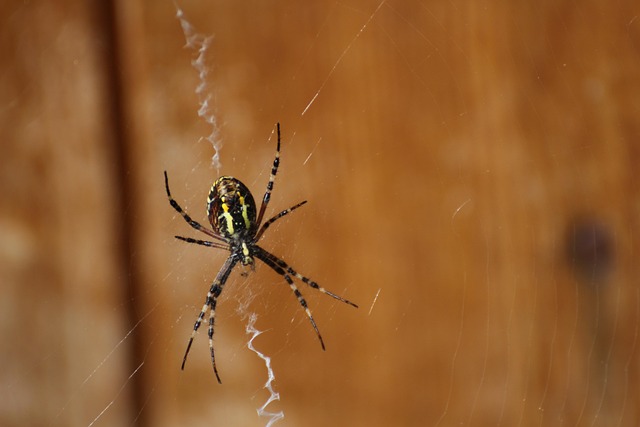To implement effective eco-friendly spider control, understand spider behavior by identifying their preferred habitats and using natural repellents like citrus, peppermint, or lavender oils. Maintain a clean environment, encourage natural predators (ladybugs, lacewings), employ physical barriers (silk traps, sticky sheets), and use safe web removal methods (vacuum cleaner with brush attachment). Adopt a multi-pronged approach including regular cleaning, sealing entry points, and using eco-friendly deterrents like citrus oils, vinegar, lavender, mint, or lemongrass to prevent infestations.
Tired of unwanted spiders in your home? Discover effective, child- and pet-safe methods for spider control and web removal with our comprehensive guide. We explore eco-friendly techniques tailored for a pest-free environment, delving into spider behavior and habitat to empower you. Learn safe removal tactics using everyday tools and prevent infestations with expert tips. Embrace a harmonious home without sacrificing safety or ecological balance.
Understanding Spiders: Behavior and Habitat
Spiders are arachnids with a complex web of behaviors and habitats that understanding is crucial for effective eco-friendly spider control. Most spiders are solitary creatures, preferring to live in quiet, undisturbed areas within homes or structures. They build intricate webs as both hunting tools and shelters, often hiding nearby to wait for prey. Knowing this behavior allows us to implement non-toxic solutions to discourage their presence without harming them.
Identifying where spiders congregate—such as corners, dark spaces, or areas with high humidity—enables the use of natural repellents like citrus scents, peppermint oil, or essential lavender oils. Additionally, maintaining a clean and clutter-free environment reduces hiding spots and food sources, making eco-friendly methods more effective in managing spider populations.
Eco-Friendly Spider Control Methods for Your Home
When it comes to spider control, many traditional methods rely on harmful chemicals that can be dangerous for children and pets. Fortunately, there are numerous eco-friendly alternatives available that keep your home pest-free without compromising safety. One effective approach is using essential oils known for their natural repellency properties. Peppermint, lemon, and lavender oil are popular choices due to their strong scents that spiders find unpleasant. You can mix these oils with water and spray the solution around windowsills, doors, and any areas where spiders are prevalent.
Another eco-friendly strategy involves using natural predators to keep spider populations in check. Certain insects like ladybugs and lacewings feed on spiders and their eggs. Introducing these beneficial bugs into your home or garden can help control spider populations naturally. Additionally, physical barriers such as silk-based traps or sticky sheets can be used to capture spiders without causing them harm. These methods not only promote a safer environment but also support the balance of nature in your living space.
Safe Removal of Spider Webs: Tools and Techniques
When it comes to removing spider webs, especially in homes with children and pets, safety is paramount. Opting for eco-friendly spider control methods not only minimizes potential harm but also helps preserve the environment. For web removal, start by using a strong vacuum cleaner equipped with a brush attachment. This method effectively sucks up webs without leaving behind any chemical residue.
For hard-to-reach areas, consider a long-handled duster or a special spider web removal tool designed with natural bristles. These tools allow for safe and efficient dislodging of webs from ceilings, corners, and other elevated surfaces. Remember to dispose of the collected webs properly by sealing them in plastic bags and placing them outside your property to prevent re-entry.
Preventing Spider Infestations: Tips for a Pest-Free Environment
To prevent spider infestations and promote a pest-free environment, several proactive measures can be taken. Regular cleaning and maintenance are key; wiping down surfaces, vacuuming floors, and washing linens at hot temperatures can help eliminate spiders and their eggs. It’s also beneficial to seal entry points such as cracks and gaps in walls or windows, using caulk or weatherstripping to prevent them from entering your space. Additionally, keeping areas clutter-free, especially storing items off the ground, makes it harder for spiders to find hiding spots and breed.
Using eco-friendly spider control methods is another crucial aspect of prevention. Instead of relying on harsh chemicals, consider natural repellents like citrus oils or vinegar, which can be effectively used to deter spiders. Planting certain herbs like lavender, mint, or lemongrass around your home can also act as a natural barrier against spiders. These organic approaches not only keep your environment safe for children and pets but also contribute to a healthier, more sustainable living space.
In light of the above discussions on eco-friendly spider control, safe web removal, and prevention strategies, it’s clear that understanding these arachnids is key to maintaining a pest-free environment while keeping both children and pets safe. By adopting natural methods and taking proactive steps, you can effectively manage spider populations without resorting to harmful chemicals. Remember that with knowledge comes power, especially when it comes to protecting your loved ones and creating a harmonious living space for all inhabitants, including the web-spinning residents of your home.
